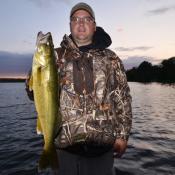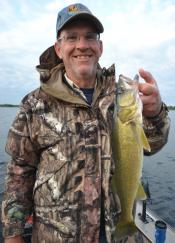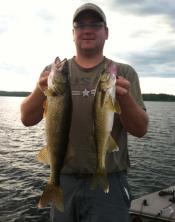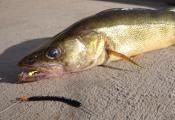 I’ve got good news and bad. The walleye bite has, predictably, slowed in most of the areas I fish. The good news? Year after year, the same small adjustments keep putting fish in the boat when fishing gets tougher. It’s always fun to put the hammer down on fish that seem to commit suicide as they thrash bait after bait, but it’s equally as fun, and much more satisfying to put together a program slowly, while enticing fish that most people seem to be missing. Don’t get me wrong, it can be a frustrating process when food becomes plentiful and the fish get choosy, but the end-reward is that much sweeter for the time spent.
I’ve got good news and bad. The walleye bite has, predictably, slowed in most of the areas I fish. The good news? Year after year, the same small adjustments keep putting fish in the boat when fishing gets tougher. It’s always fun to put the hammer down on fish that seem to commit suicide as they thrash bait after bait, but it’s equally as fun, and much more satisfying to put together a program slowly, while enticing fish that most people seem to be missing. Don’t get me wrong, it can be a frustrating process when food becomes plentiful and the fish get choosy, but the end-reward is that much sweeter for the time spent.
The walleye fishing right now, is pretty good by most people’s standards, but small details matter more and more as the bite changes. One day it’s crawlers and spinners, other days it’s really slow and deep with leeches. Wind and weather patterns dramatically change the bite, as do bug hatches which seemed to be coming off daily. The hatches might not be visible to the un-observant, but watching stomach contents from cleaned fish, and especially your electronics can tip you off to some serious bug activity in the mud. The point I’m trying to make is that everything is dynamic right now. The clues are there for you to read, but listening to what the fish and the weather tells you, then applying that knowledge as you’re fishing is what turns a decent day into a great one.
 Early Morning Fishing
Early Morning Fishing
Pre-frontal conditions are a great way to start any trip, and we started off with a few classes of fish that were great for both fun/fighting, as well as table fare. Spinners and crawlers worked well on weeds and bottom transitions in 14-18FOW, but rigging leeches seemed to take more fish deeper as the sun angle increased and the morning went on. I mentioned morning, because that’s when the fish seemed most active by far. As fishing gets more difficult in the mid-late summer months, one simple way you can put more fish in the boat is to concentrate even more on low light periods, with morning being my favorite. Anecdotally, it makes loads of sense. Between dusk and dawn, the early-morning period sees the least amount of boat traffic and pressure on any lake, and light levels are consistently more favorable for longer. This is especially true as the moon becomes full starts setting nearer dawn as was true this past weekend. 5AM comes early, but you’ve got a few hours head-start on all but the most die-hard anglers, not to mention, you get time to work out the kinks in your presentation BEFORE prime-time.
 Location and Strategy
Location and Strategy
Wind will help set-up the next day’s bite on any big lake. Fish, often are in the same area the wind left them from the previous night, but not always in the exact same locations. Using that piece of knowledge, it’s good to start with pieces of structure that were buffeted by wind in days/hours previous. My favorite places to fish mid-summer walleyes are always the easiest pieces of cover or structure to stay on the fish with as the day progresses. This would include underwater points, or small rock humps just off-shore. I stay away from the large complexes of reefs, with hundreds of intricate twists/turns. These locations are great if you have the time to figure them out, but when prime-time happens, you need to be on simple spots to find fish quickly. Then is not the time to be figuring out structure. More importantly, you need to be able to move with the fish that are there. An underwater point for example, usually starts off a morning period with fish at the base of it in shallower water. We found fish as early as a half-hour before sunrise up against scattered weeds at the shoreline-end of points in 12-15FOW. As morning light grew brighter and the sun angle increased, fish pushed out along the point, from 16-18FOW, all the way out in the mid-20 foot levels by 9AM or later. With a big enough piece of structure, we were able to stay on the same fish, keeping bait in their face during their entire march down the point into deeper water. Even when a single piece of structure didn’t produce like this, it was helpful to take this movement into account when moving around from spot to spot throughout the morning hours.
 Tricks and Tips
Tricks and Tips
The fish we pulled over were very picky about how they wanted their bait, and small games of tug-of-war with crawlers and leeches were not tolerated. Feel the weight and offer them line, or they tended to drop the bait with even the slightest bit of resistance. Getting them to get the whole bait in their mouth became more of a challenge than anything else, so we started using slightly smaller leeches, and trimming crawlers around the mid-section just behind the collar. While pumping the rod slightly did seem to attract fish, walleyes would follow on the electronics at times for 20 yards or more until they hit. It was crucial for those fish to keep the rod fairly still, slow the boat, and/or drop the sinker to let them watch the leech or worm wriggle for awhile. Quite often the fish would be already on when you picked your sinker back off the bottom. As for hook color, I’m a big fan of chartreuse and pink. Most often, I use a contrasting color single bead to the hook, as I feel this aids in visibility of the bait. As the guy who captains the boat, it’s your responsibility to inform your fellow fisherman of the small clues that you’re continually seeing on the graph. Everyone benefits in the end, and you put a lot more fish in the boat by letting your buddy know that a fish has been following his setup for the past minute. Probably the best tip I could offer the boat driver is to blow past/through poor water if the fish are concentrated. When fish are spread and sporadic, spinners and faster speeds to cover more water is the ticket. When they’re more concentrated, don’t waste time pulling over un-productive water, especially slowly via rigging.
Speaking of setup, I think Cal Svihel did a great job of detailing the same components I’m using in a recent report he did. Check out Cal’s Report for the specifics on the rigging. Hopefully this helps put some more fish in the boat this summer, even when fishing slows in the coming month or so.
Joel
Tried out some weed spots which didn’t turn up walleyes, but had some other great fish!
Kids wanted to catch pike of all things, so we trolled spinner baits in the weeds for some small pike that brought big smiles! My brother’s son even caught a nice eye while slip-bobbering.
We had more than enough overs, and plenty of eater fish to keep us happy.
Joel,
your reports do such a great job of breaking down how you put the puzzle together that they always leave me wanting more!
Two quick questions: Can you give a little more detail about how you were using your electronics to realize when fish were following your bait? Also, with water temps in the 70’s the crankbait bite is going strong on Mille Lacs with Rapala TD-11’s in the basin and Scatter Minnows/Shad Raps on the mud flats… Did you have a chance to try pulling cranks over any of the deeper structure mid-day up on Leech?
– Will
Nice post Joel the details make it easy for me to follow along with what you were doing. Last year I was able to pre-fish an FLW event on the Missouri out here and we too learned to watch the electronics a good graph can help you tell what the fish want. While trolling spinners if you moved it to much with a drop raise presentation the fish would take off. If a fish showed up and you merely held it steady you could get them to take the bait. Great way to pay attention to detail. Nice fish, looks like a good time was had by all. -QB
Great Job on the outing Joel !!!
Is Leech a place you go to each year ? I used to fish that lake back in the 80’s…
A lot has changed since then !!!
Thanks for sharing !!
Thanks Will!
Good question on the electronics part. Most people look at you funny when you say you can see a fish following their bait, but when rigging on small structure you’ll usually have a few pods of fish that you’re trying to work; all of which are quite visible trailing on sonar. If they were glued to a particular location, you’d probably jig or slip-bobber for them, but these fish are moving up and down the structure to feed depending on available light. Once I go over a good looking pod, I’ll speed up the trolling motor slightly and turn about 45 degrees off-course, then I kill the trolling motor and ramp back up in speed slowly. What this does is simply turns the boat and puts somebody’s bait directly under the transducer. This way I can see the reaction of the fish to the bait that’s being pulled through. If I start to see more fish and long trailing lines around the sinker (what the sonar picks up) I let that person know they’re being “watched.” Sometimes these fish need a trigger, and other times they just need the bait killed to swim in their face. Either way, it gives your boat-mates a heads-up and helps keep their concentration up so everyone fishes better in general. Just as importantly, it offers clues on what to do when you don’t get bit, especially when the reaction is consistent. Time then to switch snell lengths, hook/bead colors, bait choice, speed, etc.
As for crankbaits, these family trips tend to work out better when we fish hard early and/or late, then spend the bulk of the day with the kids. I brought lead-core just in case, but only broke it out for a short time with little to show for it. There’s definitely several good crankbait patterns on Leech in the summer. With the moon coming in full, I REALLY wanted to troll some of that sand/rubble towards and after dark but it wasn’t in the cards.
Maybe next time we can connect for a guys trip Will, and you can show me a few more things about pulling cranks on the big water? It’s there for the taking and I’m sure there’s plenty of guys up there doing it, you just don’t hear as much about it.
Joel
Great observation Q, and right on with what we were seeing this weekend. All the pretty lines disappeared when you bobbed the sinker up and down, so a steady hold or complete kill was better received. Neat that you guys were doing it with spinners!
Joel
Love the way you break it all down for the readers.
You actually make it easy for me to believe I’m sitting in the boat looking at the sonar while we’re all waiting for another bite.
Good read & report!